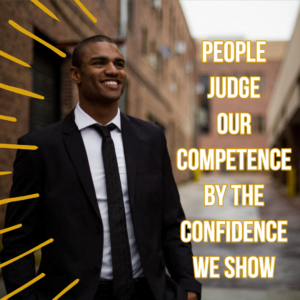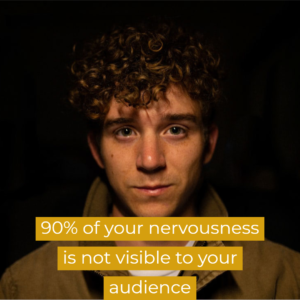
Body language in public speaking is the nonverbal cues that your movements make during communication. Presenters often focus on what they are going to say and their visual aids. However, we often overlook an important part of the speech — body language. Non-verbal communication makes a lasting impression and makes a marked difference in your communication skills. And when it comes to public speaking, if you look poised and confident, your audience will believe you are poised and confident.
In this session, we’ll cover a few simple public speaking ideas that will give you good posture and encourage better body movement. First, we show how important the power of body language is during your presentation. Next, I’ll give you a few, simple tips to look more confident and create a good impression (even if you’re nervous). Finally, I’ll share a presentation secret that, once you understand it, will change the way you look at your nervous habits forever (and in turn, help you give a great presentation).
You Body Language in Public Speaking is Important to a Successful Speech.
When presentation coaches reference body language, they often refer to a 1967 study published by Albert Mehrabian. Dr. Mehrabian is a professor at UCLA. His study showed that only 7% of communication comes from the words spoken. He said that 38% of communication comes from the voice and tone. The final 55% of the communication process comes from body language. In reality, this study has nothing to do with public speaking or presenting. So, the reference to the “Mehrabian Formula” as a reason to focus on body language in public speaking is false. However, that doesn’t mean the power of nonverbal communication isn’t important.

The better that a speaker carries himself or herself, the more credibility the speaker has with the group. If you look timid or nervous, your audience will question your competence. Confident body language has a profound effect on the unconscious mind of your audience. So much so that, even if they know you’re a new speaker, they won’t help but feel turned off by the small details, like a lack of good eye contact and other aspects of body language.
To cover for nervousness, a lot of speakers will avoid negative body language by hiding behind a lectern. Others will deliver their entire presentation from a seated position and make the slideshow the presentation. When you do these things, though, you are losing your connection to the audience. You are also, likely, inadvertently making your presentation more boring.
A Few Simple Presentation Tips to Improve Body Language
If you want to see your ability as a persuasive public speaker improve, try these simple tips. Just testing out one or two of them will show you the real impact of body language.
1. Set Your Screen to the Side, Not the Front
What? What does the screen’s placement in the room have to do with body language in public speaking? Well, everything. Many presenters will set the projection screen or digital screen in the very center of the room. When you do this, though, your ability to move around the room is significantly limited. You’re forced to work in a smaller “stage” to present from, and you’re now off to the side. Your audience didn’t come to see you click through bullet points. They came to hear you speak.
2. Take a Deep Breath and Drop Your Hands to Your Side.
Please don’t misunderstand this tip. The tip ISN’T to KEEP your hands by your side. It’s just the opposite. When you start your presentation with your hands dropped loosely by your side, your first gesture will be bigger and more powerful. This is a powerful tool you can try from wherever you are right now.
Stand up and clasp your hands together in front of your waist as most presenters do. Now, break the clasp and try to make a gesture with one of your hands. Try it a few times. When you do, you will notice that your elbow will tend to rest around your hip. The gesture will look robotic. If you alternate moving your hands from that clasped position, you will likely look like a t-rex. Fearless Presentations, I mentioned in the book that “People judge our competence by the confidence that we show.” This statement is so true.

Now, drop both hands to your side and let them hand loosely. Try to make the same gesture that you did before. When you do, you will, most likely end up moving BOTH hands. This time, the gesture will look more powerful and energetic. Also, when you stop making the gesture, you will probably return your hands to your side so that your next gesture is also powerful. (Your hands will often return to their starting point.)
If you’re having trouble remembering to drop your hands to your side, try one of these 3 tips:
Incorporate Slow Breathing and a Relaxed Stance: Begin your presentation with slow breathing and a relaxed body language, keeping your hands at your sides. This not only calms your nerves but also sets a composed tone for your speech. A relaxed physical presence goes a long way in making your delivery appear confident and effortless. Remember, a calm demeanor and tone of voice can make a big difference in public speech.
Practice Purposeful Gestures and Open Palms: When rehearsing, focus on using your whole body to make purposeful and open gestures. An open palm can signal honesty and active participation from the audience. Treat this as a learned skill, where each movement, including returning your hands to your sides, is a part of your physical expression. This technique enhances audience engagement and ensures your gestures complement the tone of your voice.
Visual Cues and Physical Movements Checklist: Create a checklist of physical movements, including keeping your hands at your sides, which you can refer to as an exhaustive list during practice. This list can act as a reminder that each aspect of your body language, from your gestures to your posture, contributes to a great idea being effectively communicated. Regular practice with these visual cues helps in embedding these actions into your muscle memory, ensuring a more natural and engaging delivery.
3. Tell More Stories
If you want to have great body language when presenting, tell more stories. It is almost impossible to tell a story without using your hands to explain what is happening. For instance, when I start my presentation skills seminars, I will often start with a story. Typically, I tell the class what happened to me the first time I had to speak in front of a room of executives. As I describe how my hands got sweaty, I often naturally rub my palms on my pants. When I tell them how I zoomed through the presentation, I move my hands quickly in small circles. These movements add clarity to my description. No one ever taught me how to do this. These gestures happen naturally as I relive the incident from memory.
These natural gestures add a lot of enthusiasm and fun to your presentations. So, if you want to use more poised body language, tell more stories.
Here are some additional tips on incorporating gestures into your presentation:
Mimic the Action: When narrating an event or action in your story, mimic the movement with your hands or body. For example, if you’re talking about opening a door to a new opportunity, physically mimic the action of turning a door handle and pushing a door open. This not only makes your story more vivid and engaging but also helps the audience visualize the scenario better.
Use Symbolic Gestures: Incorporate gestures that symbolize concepts or emotions in your story. If you’re discussing overcoming obstacles, you might show pushing against an invisible barrier with your hands. For stories involving growth or progression, use upward or forward-moving hand motions. These symbolic gestures can powerfully convey abstract ideas and emotions, enhancing the impact of your story.
Avoid Overuse of Gestures: While gestures can greatly enhance your storytelling, it’s important to use them judiciously. Be mindful not to overcrowd your narrative with excessive or exaggerated gestures, as this can distract or even confuse the audience. The key is to ensure that your gestures feel natural and spontaneous, complementing rather than dominating the story. Let your movements flow organically from the narrative; if a gesture doesn’t feel natural or necessary, it’s often better to omit it. This approach maintains the authenticity and impact of your storytelling.
4. Use Your Visual Aid
One of the things that bug me most is when a speaker stands (or sits) clicking a clicker. If you are going to take the time to create a great slide or visual aid… USE IT! One of the techniques that we cover in our speaking class is to visually touch your slide. I know it sounds weird, but it works like magic.
Have you ever been in a presentation where a speaker puts up a series of bullet points and just starts talking? As he presents, you may think he is on point four, but then he clicks to the next slide. This occurs because the speaker naturally assumes that you can figure out which point he is on. As a result, he doesn’t both to tell you when he moves from one point to the next. In most cases, the points aren’t clearly defined, anyway, so there is a lot of overlap. This makes the entire presentation confusing.
A better way is to physically go to the screen and point to bullet #2 when you move to bullet #2. If you combine this technique with telling a story, your presentation comes alive. This happens because the speaker will move toward the screen to identify the next point. Then, she will jump into an example or story to clarify the point. She will naturally move back toward the audience as she tells the story. Of course, as she tells the story, she will use those natural gestures as well. This combination of techniques adds a lot of enthusiasm and energy to a presentation.
A Presentation Secret that Should Help with Presentation Gestures
This is a presentation secret that most people don’t realize. (I guess that is because it is a secret.) Most of the stuff that happens to us when we get nervous is not seen by your audience. When we have public speaking fear, we may have shaky hands, a faster heart rate, butterflies in the stomach and the like. However, although these things are real — we feel them — the audience will likely not realize you are experiencing these symptoms. For instance, if you feel queasy, as long as you don’t throw up, your audience will never know. If your heart is beating faster, again, that is an internal feeling, not an outward manifestation. This is why most people think that they are the only speaker who gets nervous.
(I guess that is because it is a secret.) Most of the stuff that happens to us when we get nervous is not seen by your audience. When we have public speaking fear, we may have shaky hands, a faster heart rate, butterflies in the stomach and the like. However, although these things are real — we feel them — the audience will likely not realize you are experiencing these symptoms. For instance, if you feel queasy, as long as you don’t throw up, your audience will never know. If your heart is beating faster, again, that is an internal feeling, not an outward manifestation. This is why most people think that they are the only speaker who gets nervous.
In reality, most speakers feel nervousness. It is just that most of the symptoms they feel aren’t visible either.
If you understand this and use a few of the tips we covered earlier, you can look very poised when you speak. (Even if you are nervous!)
